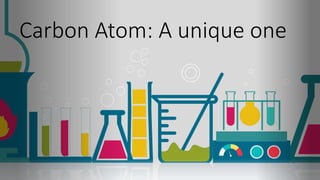Carbon atoms and its unique properties.pptx
•Download as PPTX, PDF•
0 likes•6 views
Carbon atom
Report
Share
Report
Share

Recommended
More Related Content
Similar to Carbon atoms and its unique properties.pptx
Similar to Carbon atoms and its unique properties.pptx (20)
Recently uploaded
Recently uploaded (20)
Discovery of an Accretion Streamer and a Slow Wide-angle Outflow around FUOri...

Discovery of an Accretion Streamer and a Slow Wide-angle Outflow around FUOri...
Asymmetry in the atmosphere of the ultra-hot Jupiter WASP-76 b

Asymmetry in the atmosphere of the ultra-hot Jupiter WASP-76 b
VIRUSES structure and classification ppt by Dr.Prince C P

VIRUSES structure and classification ppt by Dr.Prince C P
All-domain Anomaly Resolution Office U.S. Department of Defense (U) Case: “Eg...

All-domain Anomaly Resolution Office U.S. Department of Defense (U) Case: “Eg...
Labelling Requirements and Label Claims for Dietary Supplements and Recommend...

Labelling Requirements and Label Claims for Dietary Supplements and Recommend...
Disentangling the origin of chemical differences using GHOST

Disentangling the origin of chemical differences using GHOST
Physiochemical properties of nanomaterials and its nanotoxicity.pptx

Physiochemical properties of nanomaterials and its nanotoxicity.pptx
Unlocking the Potential: Deep dive into ocean of Ceramic Magnets.pptx

Unlocking the Potential: Deep dive into ocean of Ceramic Magnets.pptx
Botany krishna series 2nd semester Only Mcq type questions

Botany krishna series 2nd semester Only Mcq type questions
Pulmonary drug delivery system M.pharm -2nd sem P'ceutics

Pulmonary drug delivery system M.pharm -2nd sem P'ceutics
Stunning ➥8448380779▻ Call Girls In Panchshil Enclave Delhi NCR

Stunning ➥8448380779▻ Call Girls In Panchshil Enclave Delhi NCR
Recombinant DNA technology (Immunological screening)

Recombinant DNA technology (Immunological screening)
fundamental of entomology all in one topics of entomology

fundamental of entomology all in one topics of entomology
Carbon atoms and its unique properties.pptx
- 1. Carbon Atom: A unique one
- 2. VALENCE ELECTRONS Carbon atoms’ four valence electrons can be shared by different particles that have electrons to share, consequently framing covalent (shared-electron) bonds
- 3. BOND LENGTH Carbon atom has the ability to form long carbon-to-carbon chains. It can tie with one another in straight chains, yet in complex branching, similar to the parts of a tree.
- 4. STRENGTH The carbon–carbon single bond is a sigma bond and is formed between one hybridized orbital from each of the carbon atoms. Sigma bonds are the strongest kind of covalent bond
- 5. MULTIPLE BOND FORMATION It can impart not just one electron to another atom to form a single bond, it can likewise share two or three electrons, framing a double or triple bond.
- 6. MULTIPLE BOND FORMATION It can impart not just one electron to another atom to form a single bond, it can likewise share two or three electrons, framing a double or triple bond.
- 7. Organic compounds Organic compounds are group of compounds that contain the element carbon and hydrogen. It consistently contains carbon with other different elements that are required for living creatures to work.
- 8. 4 types of Organic Compounds 1. Hydrocarbons or Carbohydrate 2. Lipids 3. Proteins 4. Nucleic Acids
- 9. 4 types of Organic Compounds 1. Hydrocarbons or Carbohydrate 2. Lipids 3. Proteins 4. Nucleic Acids
- 10. Carbohydrates Biochemical that are made up of one or more simple sugar molecules. Living things use carbohydrates as an energy source.
- 11. Lipids are biochemical that does not dissolve in water. Fats, oils, and waxes are examples of lipids. One of the functions of lipids in living things is to store energy.
- 12. Proteins are huge molecules with complex structures that permit them to take on significant functions in organic chemical reactions. Proteins do most of the work in cells and are essential for the organization, function, and regulation of the body's tissues and organs.
- 18. INORGANIC An inorganic compound is a compound that does not contain both carbon and hydrogen.
- 19. A great many inorganic compound do contain hydrogen atoms, such as water (H2O) and the hydrochloric acid (HCl) produced by your stomach. In contrast, only a handful of inorganic compounds contain carbon atoms. Carbon dioxide (CO2) is one of the few examples.
- 20. Inorganic compounds contain some kind of metal (alkali, alkaline, transition and so forth.), they will in general have the capacity to conduct electricity.
- 21. Because of ionic bonding commonly found in inorganic compounds, they are held together tightly and have extremely high melting and boiling points.
- 22. Transition metal inorganic compounds, in any event, sitting on a seat top, are generally profoundly colored, and this is, once more, because of the arrangement of the 'd-block’s' electrons.
- 23. Likewise, inorganic compounds are normally highly soluble in water. In other words, they can 'vanish' when put into water since they will basically dissolve. One more uncovering quality of inorganic compounds is their capacity to form crystals.
- 24. EXAMPLE OF INORGANIC COMPOUNDS